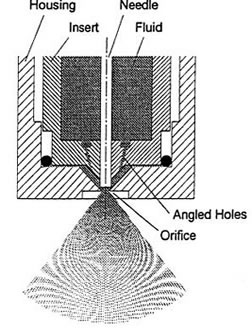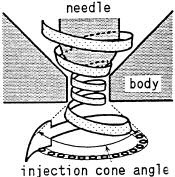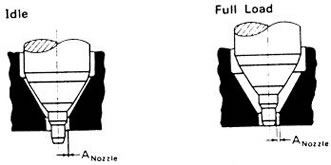Direct Injection
Starting with the 2014 season, Formula 1 regulations shift drastically, and the most significant change is the switch from 2.4-liter normally aspirated V8 engines to 1.6-liter direct-injected turbocharged V6 units. In an effort to reduce fuel consumption by up to 35% the FIA have introduced changes to the technical regulations to significantly increase harvesting of normally lost energy and reduce losses of used energy. To do that, FIA made drastic changes in ICE combustion system introducing direct injection (DI).
Formula One engine regulations for 2013 and before specified only port, MPFI injection fuelling systems. With regulation 5.10.2 stating:
5.10.2 Only one fuel injector per cylinder is permitted which must inject directly into the side or the top of the inlet port.
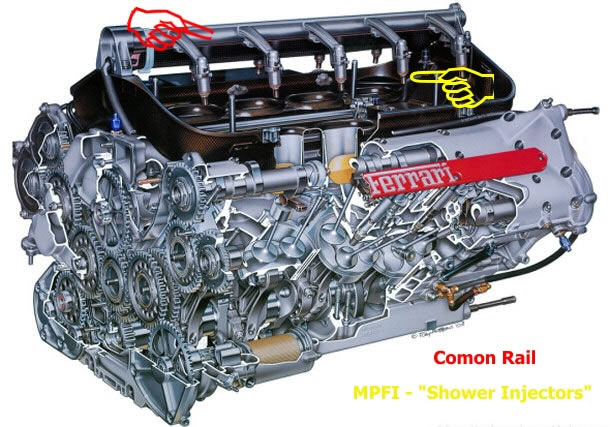
So, position of injector was limited to upper side (upstream) of inlet port (valve). Here's how it works: rather than using one injector that sprays about the right amount of fuel, each of the individual intake trumpets has its own injector that adds a precise squirt of aerosolized fuel to the intake air from a pressurized injector. The air and fuel mixture is drawn into the open port and into the combustion chamber by the retreating piston. The intake valve then slams shut, spark plug fire and the explosive combustion happens in the now sealed cylinder.
But for 2014 this restriction is left out. So, while previously direct injection has been specifically excluded with injector positioning limit, starting in March 2014 it must be the only way to go. Direct Injection has been made compulsory. With regulation 5.10.2 now stating:
5.10.2 There may only be one direct injector per cylinder and no injectors are permitted upstream of the intake valves or downstream of the exhaust valves.'
So, position of injector is fixed inside cylinder.
There are long years already that Formula 1 is using electronically controlled injection, but arrangement was different. Engines were equipped with "port injection fuelling systems" or so called multi-point fuel injection (MPFI) with so called "Shower 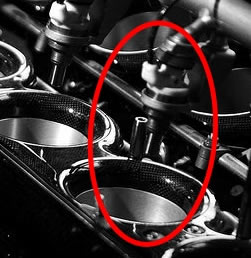 Injectors", with injectors located before intake trumpets. You can actually see injector spray. This arrangement allows fuel to be sucked with air inside cylinder. When you mount the injectors further away from the combustion chamber you have a more efficient air/fuel mixing effect and additional cooling effect. The cooler the intakes charge the better combustion and less pre detonation. And that will result in more power. Trade off is less fuel efficiency, but more power with proper combustion. Some part of injected fuel remains attached on the walls of trumpets and intake channels.
Injectors", with injectors located before intake trumpets. You can actually see injector spray. This arrangement allows fuel to be sucked with air inside cylinder. When you mount the injectors further away from the combustion chamber you have a more efficient air/fuel mixing effect and additional cooling effect. The cooler the intakes charge the better combustion and less pre detonation. And that will result in more power. Trade off is less fuel efficiency, but more power with proper combustion. Some part of injected fuel remains attached on the walls of trumpets and intake channels.
So, FIA decided to go with direct injection. Direct fuel injection is a fuel-delivery technology that allows gasoline engines to burn fuel more efficiently, resulting in more power, cleaner emissions, and increased fuel economy. All of this is relevant for modern consumer's car technology.
The most fundamental characteristic of any engine – be it diesel, gasoline, two- or four-stroke – is its combustion system. The two most critical differences between a direct injection engine and a standard gasoline engine are how they deliver fuel and how the fuel mixes with incoming air. These basic premises make a tremendous difference in an engine's overall efficiency.
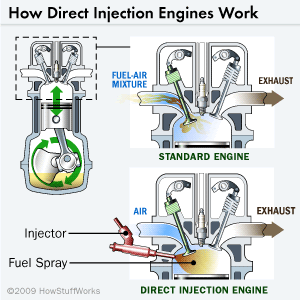 Gasoline engines work by sucking a mixture of gasoline and air into a cylinder, compressing it with a piston, and igniting it with a spark. The resulting explosion drives the piston downwards, producing power and torque. Traditional (indirect) fuel injection systems (carburetor, single point and multipoint injection) pre-mix the gasoline and air in an intake manifold, before entering the cylinder. The fuel air mixture disperses widely within the chamber, leaving a substantial amount unburned and therefore ineffective.
Gasoline engines work by sucking a mixture of gasoline and air into a cylinder, compressing it with a piston, and igniting it with a spark. The resulting explosion drives the piston downwards, producing power and torque. Traditional (indirect) fuel injection systems (carburetor, single point and multipoint injection) pre-mix the gasoline and air in an intake manifold, before entering the cylinder. The fuel air mixture disperses widely within the chamber, leaving a substantial amount unburned and therefore ineffective.
Virtually all diesel engines use direct fuel injection. However, because diesels use a different process to combust their fuel (gasoline engines compress a mixture of gasoline and air and ignite it with a spark; diesels compress only air, then spray in fuel which is ignited by the heat and pressure), their injection systems differ in design and operation from gasoline direct fuel injection systems.
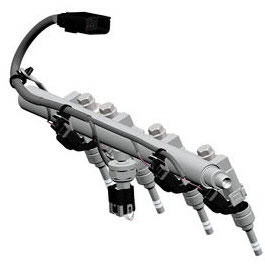 |
Common rail for 4 cylinder gasoline direct injection engine. The fuel-injection system on the gasoline direct injection engine consists of a high-flowing fuel pump, a large-diameter fuel rail (Common rail, the tube that holds highly pressurized fuel), and specialized fuel injectors. The injectors can survive the excessive temperature and pressure of combustion by using the fuel that passes through it as a coolant. |
In a direct-injection system, the air and gasoline are not pre-mixed. Air comes in via the intake manifold, while the gasoline is sprayed at high pressure directly into each cylinder via specially designed injectors. The fuel apply rate is tuned via the pressure in the common fuel rail that the fuel injectors are connected to, the number of times the injector is opened to allow fuel to pass through it during the intake cycle, and the duration of those openings. DI fuel systems are substantial in their design because they usually generate and hold fuel pressurized at a 150 bar or more rather than the 3 to 5 bar common in port multipoint injection. These extremely high pressures allow the injector to flow enough fuel to achieve combustion. With an assist from modern engine management computers, the fuel gets burned right where it's needed and when it's needed. The fuel can be squirted directly where the combustion chamber is hottest, up close to the spark.
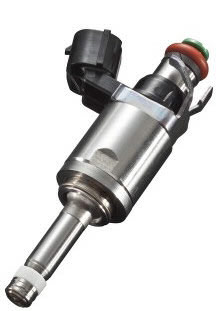 |
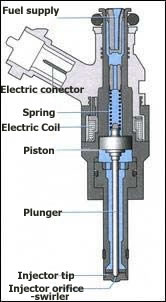 |
Compared with a conventional
port MPFI fuel injection system, the fuel
injectors must be capable of working
with huge fuel pressures, extremely high temperatures and also injecting
large amounts of fuel in very short periods. |
|
The spray duration and intensity can be fine-tuned by the engine's computer, allowing faster, more complete combustion. The result is less fuel consumption, less pollution (General Motors says it reduces cold-start emissions by 25 percent) and greater power. For example, before the 3.5-liter V6 in the Mercedes E350 received direct injection, it was delivering 268 horsepower and a rather lousy EPA rating of 7,2 km/L city/10.2 km/L highway. Now, with basically same engine, thanks in good part to direct injection, the E350 can deliver 302 horsepower and achieves a respectable 8.5 km/L city/12.7 km/L highway rating. Cadillac sells the CTS with both indirect and direct injection versions of its 3.6 liter V6 engine. The indirect engine produces 263 horsepower and 343 Nm of torque, while the direct version develops 304 hp and 371 Nm.
The inventor of direct gasoline injection is French inventor of the V8 engine configuration, Leon Levavasseur in 1902. The first post-World War I example of direct gasoline injection was on the Hesselman engine invented by Swedish engineer Jonas Hesselman in 1925. Hesselman engines used the ultra lean burn principle and injected the fuel in the end of the compression stroke and then ignited it with a spark plug. But it didn't start here. the first
attempts go back more than 100 years. The German engine builder Deutz produced some beginning in 1898!
Why? Because at that time the venturi-effect carburettor had not yet been discovered, so DI looked like a good
way to get fuel into the cylinders. During the Second World War Direct gasoline injection was used on almost all higher-output production aircraft engines made in Germany, the Soviet Union and the US.
The first automotive direct injection system used to run on gasoline was developed by Bosch, and was introduced by Goliath and Gutbrod in 1952. This system used a normal gasoline fuel pump, to provide fuel to a mechanically driven injection pump, which had separate plungers per injector to deliver a very high injection pressure directly into the combustion chamber.
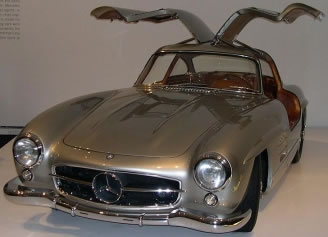 The 1955 Mercedes-Benz 300SL (Picture right), the first production sports car to use fuel injection, used direct injection. The Bosch fuel injectors were placed into the bores on the cylinder wall used by the spark plugs in other Mercedes-Benz six-cylinder engines (the spark plugs were relocated to the cylinder head).
The 1955 Mercedes-Benz 300SL (Picture right), the first production sports car to use fuel injection, used direct injection. The Bosch fuel injectors were placed into the bores on the cylinder wall used by the spark plugs in other Mercedes-Benz six-cylinder engines (the spark plugs were relocated to the cylinder head).
Later, more mainstream applications of fuel injection favored the less-expensive indirect injection methods. But all this early projects in automotive industry are canceled because electronic controls, a key element, did not exist or was in their infancy and pump and injector costs were extremely high. Today, gasoline DI engines is appearing in entry-level models, and if you see GDI, FSI, DFI, SIDI, Skyactiv or EcoBoost on a car's rear end, it's referring to direct injection. Hyundai offers direct injection on seven of its models, including the Sonata and entry-level Accent. Kia does the same on five of its models, including its cheapest Rio. Chevrolet packs it on the V6 Camaro and on the current Impala, very strange in a car that advertises a CD player as its coup de grace. Audi offers it on every model, including the V10 R8 and 12-cylinder A8.
Diesel engines have used direct injection for many years, but only the people who've bought VW TDI truly know about that.
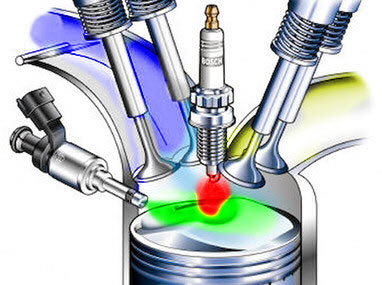 Gasoline DI is a relatively new stuff in consumer car technology. An advanced injection system that, with sophisticated strategies of injections combined with turbocharger, allow smaller engine, improved performances, and significant reductions in fuel consumption and emissions. Combined with ultra-precise computer management, direct injection allows more accurate control over fuel metering (the amount of fuel injected) and injection timing (exactly when and for how long the fuel is introduced into the cylinder). Part of ECU responsible for fuel management has to think a lot quicker. That's because the fuel management system
Gasoline DI is a relatively new stuff in consumer car technology. An advanced injection system that, with sophisticated strategies of injections combined with turbocharger, allow smaller engine, improved performances, and significant reductions in fuel consumption and emissions. Combined with ultra-precise computer management, direct injection allows more accurate control over fuel metering (the amount of fuel injected) and injection timing (exactly when and for how long the fuel is introduced into the cylinder). Part of ECU responsible for fuel management has to think a lot quicker. That's because the fuel management system 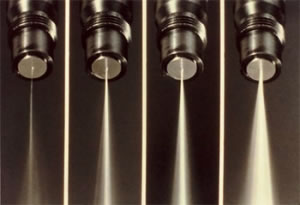 must pulse fuel into the cylinders at much shorter intervals, and in general, the precise rationing of fuel and manipulation of air-fuel ratios is more crucial on a direct injection engine in order to optimize performance, emissions and fuel efficiency. The location of the injector also allows for a more optimal spray pattern that breaks the gasoline up into smaller droplets. The result is more complete combustion. Also, GDI system has more flexibility regarding when in the combustion cycle the fuel is added. MPFI systems can only add fuel during the intake stroke of the piston, when the intake valve is open. GDI can add fuel whenever it needs to, also a few smaller squirts in place of one. Some automakers have even experimented with using GDI to fire an additional burst of fuel into the cylinder to create secondary explosion during the combustion cycle, resulting in potentially even more power and efficiency. This adjustability in when the fuel is added to the cylinder is the holy grail of power production.
must pulse fuel into the cylinders at much shorter intervals, and in general, the precise rationing of fuel and manipulation of air-fuel ratios is more crucial on a direct injection engine in order to optimize performance, emissions and fuel efficiency. The location of the injector also allows for a more optimal spray pattern that breaks the gasoline up into smaller droplets. The result is more complete combustion. Also, GDI system has more flexibility regarding when in the combustion cycle the fuel is added. MPFI systems can only add fuel during the intake stroke of the piston, when the intake valve is open. GDI can add fuel whenever it needs to, also a few smaller squirts in place of one. Some automakers have even experimented with using GDI to fire an additional burst of fuel into the cylinder to create secondary explosion during the combustion cycle, resulting in potentially even more power and efficiency. This adjustability in when the fuel is added to the cylinder is the holy grail of power production.
DI is inherently more efficient and helps generate more power than port injection. And advances in engineering and electronic engine management, fueled by fierce industry competition and consumer demand, are making DI technology more cost-effective than ever for manufacturers. GDI direct injection represents an effective powertrain technological solution in order to fall in step with the trend of emission. Direct-injection is becoming commonplace in new cars thanks to its positive effect on fuel efficiency. The requirements for higher fuel efficiency being stipulated by the EPA assure direct injection will be an increasingly common technology on cars going forward and automakers will have to figure out how to make it durable and cost effective.
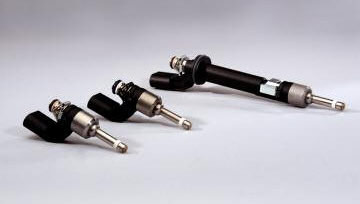 But there has been also a dark side to the technology. There is a process of getting the technology to not only work but to be durable and cost effective. There are many longevity concerns with direct injection equipped engines. For example, the high pressure injection used in these engines causes a lot of stress on the fuel pumps. Regular fuel pumps in non-direct injected applications operate at much lower pressure than the high-pressure fuel pumps in direct-injected power-plants.
But there has been also a dark side to the technology. There is a process of getting the technology to not only work but to be durable and cost effective. There are many longevity concerns with direct injection equipped engines. For example, the high pressure injection used in these engines causes a lot of stress on the fuel pumps. Regular fuel pumps in non-direct injected applications operate at much lower pressure than the high-pressure fuel pumps in direct-injected power-plants.
The biggest concern with direct-injection technology is with carbon buildup around intake valves. Over the time this can degrade power and efficiency, eroding the bonus 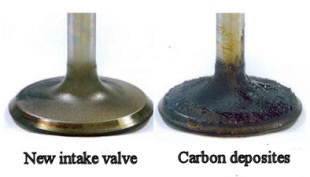 DI is supposed to provide. Unlike in port fuel-injected engines, where a constant spray of fuel into the port and over the valves allows any deposits to be washed away, with DI engines, the fuel gets injected directly into the combustion chamber, so there isn't a chance for the deposits to be washed away. Typically, deposits form when soot – which is an end-product of combustion – adheres to the valve stem. The problem for most affected engines can be traced to the breathing system. Specifically, the design of its crankcase ventilation and exhaust-gas recirculation components. All modern gasoline engines return some crankcase and exhaust gases back through the intake manifold in order to help control emissions, but some exhaust-gas recirculation designs are “dirtier" than others. Some are less-effective at preventing the passage of tiny bits of oil, carbon and other particulates that eventually get baked onto the intake ports and valves. A “dirty” intake or exhaust-recirculation design can easily go undetected in a conventional port-injected engine due to the cleaning effect of gasoline passing over the intake valves. When the same engine designs are adapted to direct-injection fueling, however, that cleaning effect is suddenly lost – and the carbon layers can build. Newer implementations of direct-injection are designed around these problems. Toyota’s D-4S system that is in use in some of its cars such as the Scion FR-S and Lexus GS350 have a second set of port injectors (not direct injectors) that run only when is needed to help clear off the carbon build up and optimize performance.
DI is supposed to provide. Unlike in port fuel-injected engines, where a constant spray of fuel into the port and over the valves allows any deposits to be washed away, with DI engines, the fuel gets injected directly into the combustion chamber, so there isn't a chance for the deposits to be washed away. Typically, deposits form when soot – which is an end-product of combustion – adheres to the valve stem. The problem for most affected engines can be traced to the breathing system. Specifically, the design of its crankcase ventilation and exhaust-gas recirculation components. All modern gasoline engines return some crankcase and exhaust gases back through the intake manifold in order to help control emissions, but some exhaust-gas recirculation designs are “dirtier" than others. Some are less-effective at preventing the passage of tiny bits of oil, carbon and other particulates that eventually get baked onto the intake ports and valves. A “dirty” intake or exhaust-recirculation design can easily go undetected in a conventional port-injected engine due to the cleaning effect of gasoline passing over the intake valves. When the same engine designs are adapted to direct-injection fueling, however, that cleaning effect is suddenly lost – and the carbon layers can build. Newer implementations of direct-injection are designed around these problems. Toyota’s D-4S system that is in use in some of its cars such as the Scion FR-S and Lexus GS350 have a second set of port injectors (not direct injectors) that run only when is needed to help clear off the carbon build up and optimize performance.
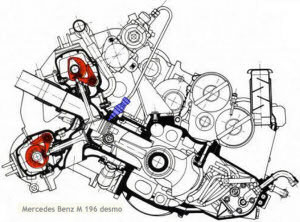 |
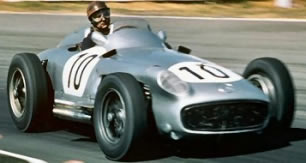 |
The Mercedes-Benz W196 was the Mercedes-Benz Formula One racer in the 1954 and 1955 Formula One seasons, winning 9 of 12 races entered in the hands of Juan Manuel Fangio (pictured with No 10) and Stirling Moss. It used straight eight-cylinder M196 engine pictured above (click for bigger resolution). It was the first to include desmodromic valves and fuel injection developed by Mercedes engineers through experience gained on the DB 600 series of engines used on the Messerschmitt Bf 109 fighter and others during World War II. |
|
Direct injection is nothing new in motorsport. The Mercedes Grand Prix racer used a mechanical system to inject the fuel through the side of the cylinder in its straight eight-cylinder M196 (powering famous Mercedes-Benz W196 Formula 1 racer), and with this winning the world championships in 1954 and 1955.
In 2001 Audi brought its twin-turbo 3.6 liter V8, winning Le Mans that year. By this time of course, many other manufacturers began to see the advantages of increased power (up to 5%) and better fuel consumption (up to15%). But like many things in life, such improvements don’t come easily, and while the potential benefits of improved cylinder filling and better mixture preparation are highly attractive, to achieve them takes a lot of painstaking development work.
|
Position of the nozzle needle in two extremes of engine, idle and full load. You can see difference in gap -A-.On picture left you can see internals of the injector tip swirler and spray of the AlliedSignal high-pressure swirl injector and and spray characteristics of a high-pressure, swirl injector.The gains are achieved by the precise control over the amount and timing of fuel injection that are varied according to engine load. Adding this functionality to the ECU requires considerable enhancement of ECU processing and memory, as direct injection plus the engine speed management must have very precise algorithms for good performance and drivability. The engine management system continually |
chooses among combustion engine maps: lean burn, stoichiometric, full power and few in between. Each mode is characterized by the air-fuel ratio. The stoichiometric air-fuel ratio for gasoline is 14.7:1 by weight (mass), but lean mode can involve ratios as high as 50:1. Lean burn or stratified charge mode is used for light-load running conditions. In this mode fuel is not injected at the intake stroke but rather at the latter stages of the compression stroke. Great for fuel saving. Stoichiometric mode is used for moderate load conditions and Full power mode is used for rapid acceleration and heavy loads.
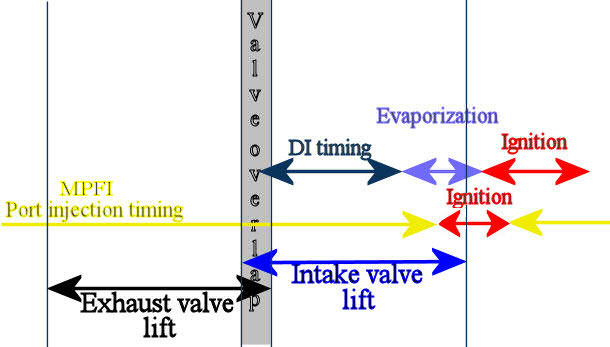 |
The injectors on a port fuel injection (MPFI) engine can flow (inject) fuel for almost the entire 720 degrees of crank rotation (at lower RPM they close occasionally, but at higher rpm they can be open for as long as 720 degrees). This is acceptable as the fuel/air mixture filling the intake ports only flows into the combustion chambers when the intake valve is open. In a DI engine, injection can’t even start until the inlet valve opens, and then only when there is no chance of the fuel escaping through the exhaust valve during valve overlap. Start of injection will therefore be at or close to exhaust valve closing time. |
In a port-injected engine the fuel can be injected over much of the four-stroke cycle, with injection ending as the intake valve closes. At, say, 10,000 rpm this injection period may be something of the order of 12 ms. In a DI engine, injection can’t even start until the inlet valve opens, and then only when there is no chance of the fuel escaping through the exhaust valve during valve overlap. Start of injection will therefore be at or close to exhaust valve closing time. After injection, the fuel has to be given sufficient time to evaporate to create a combustible mixture before it can be fired by the spark. At this same 10,000 rpm, the time for this to happen falls to somewhere nearer 1.6 ms. Increasing the engine speed to the maximum of that now allowed in Formula 1 (15,000 rpm) reduces this time for evaporation and mixing still further.
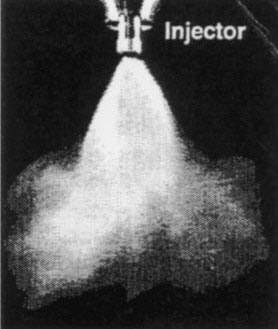 In Formula 1 this is not so big problem, since under the new 2014 regulations fuel rail pressures is max 500bar, which is considerably higher then in other applications of DI. However, with 15.000 RPM's getting the correct air-fuel mixture at the correct time in the engine cycle sequenced to the position of the piston, and ensuring that this mixture burns quickly and completely in cylinder of 80mm diameter, takes a great deal of understanding of the airflow in the cylinder. This, as well as the progression of the flame front across the 80mm wide combustion chamber, requires much more knowledge of the in-cylinder flows at any particular instant than with our port-injected engine. Countless hours of CFD work will have been undertaken to model both air and fuel mixing.
In Formula 1 this is not so big problem, since under the new 2014 regulations fuel rail pressures is max 500bar, which is considerably higher then in other applications of DI. However, with 15.000 RPM's getting the correct air-fuel mixture at the correct time in the engine cycle sequenced to the position of the piston, and ensuring that this mixture burns quickly and completely in cylinder of 80mm diameter, takes a great deal of understanding of the airflow in the cylinder. This, as well as the progression of the flame front across the 80mm wide combustion chamber, requires much more knowledge of the in-cylinder flows at any particular instant than with our port-injected engine. Countless hours of CFD work will have been undertaken to model both air and fuel mixing.
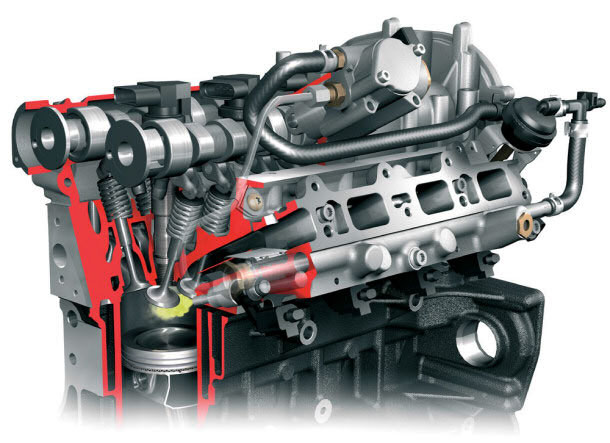
Race to extract maximum performance out of allowed 100 kg of the fuel has started.
Back to the top of the page

